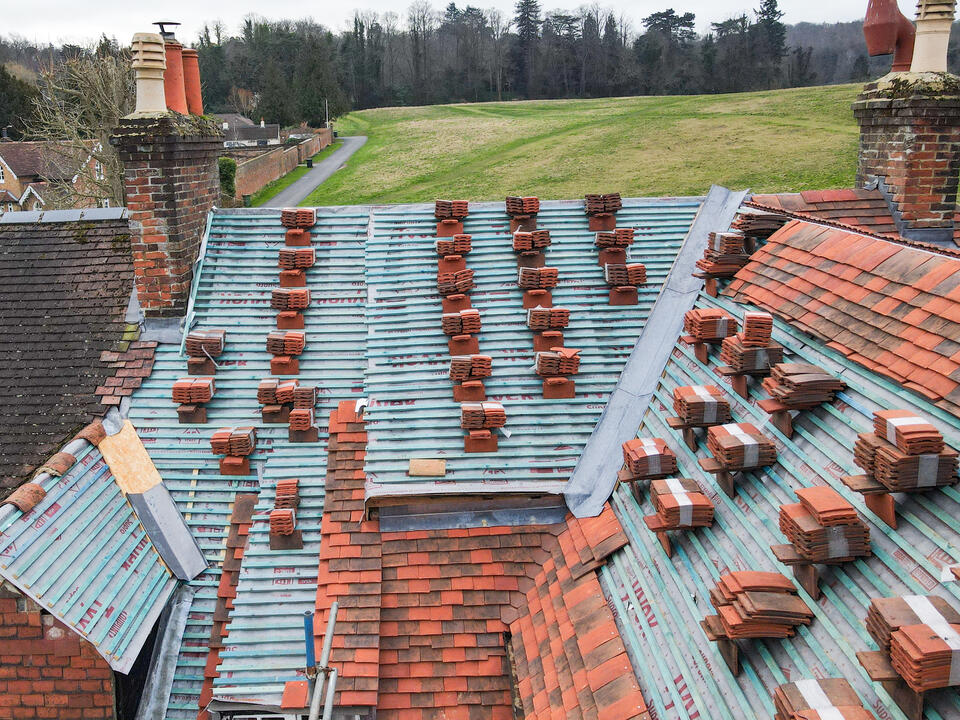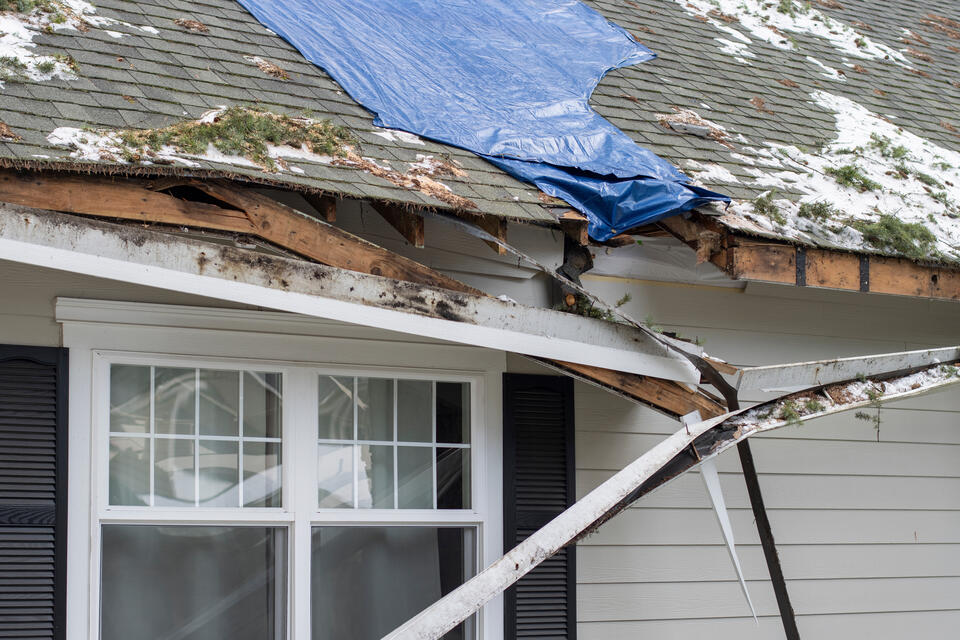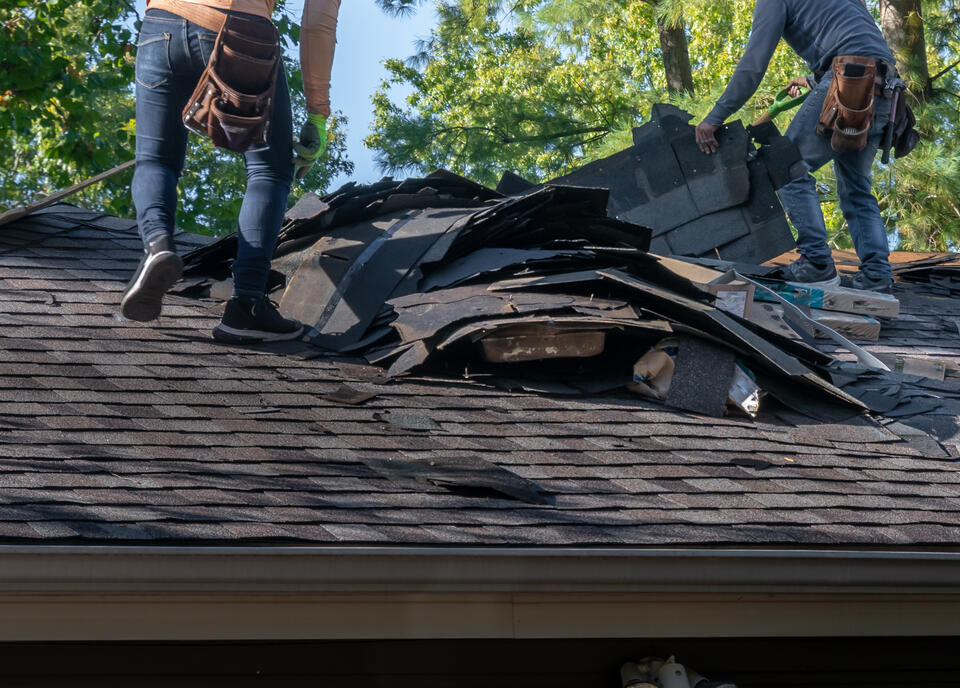Does Your Homeowners Insurance Cover a Roof Replacement?
Although homeowners insurance is a requirement in most states, many homeowners don’t fully understand what their policy covers. The minutiae of the different coverages can be overwhelming! That said, coverage for your roof is something you can’t go without. A roof replacement is expensive, and you don’t want to be caught unprotected. You’ve probably wondered, “Does homeowners insurance cover roof replacement?” Here’s what our Bentonville roofers from Shamrock Roofing and Construction say you need to know about securing your home’s biggest asset:
- Understanding homeowners insurance
- Is my roof covered?
- 11 steps to filing a claim for roof replacement
- Tips for ensuring coverage
🤔 Understanding Homeowners Insurance

Homeowners insurance is designed to protect your home and personal property from various risks. Typically, it covers damage caused by events like:
- Fire
- Theft
- Vandalism
- Certain natural disasters
Additionally, homeowners insurance often includes liability protection in case someone is injured on your property, making it crucial to know the specifics of your policy. Each policy can vary significantly in terms of coverage limits, exclusions, and deductibles. Familiarizing yourself with these details ensures that you are adequately protected and can make informed decisions regarding claims or adjustments to your coverage. Understanding your homeowners insurance can provide peace of mind and financial security for you and your family.
🏠 Is My Roof Covered?
Typically, home insurance policies cover a roof replacement if damage occurs. However, there are some caveats to be aware of. Many policies stipulate that the roof damage must occur due to weather or other “acts of God.” That means damage from negligence or lack of maintenance won’t fly. And not all weather conditions reap a payout. Weather occurrences like hail or storm damage are often dubbed cosmetic and may not be covered.
Another thing to be aware of is that many homeowners policies only cover the cash value of a roof, not the replacement cost. That means if you file a claim, you may only get a check for the current value of the roof, which may have been well into its life when disaster struck. Your claim check probably won’t provide the money you need to install a brand-new roof using the same type of materials.
Other factors like age, the quality of roofing materials used, and whether a roof was installed properly also come into play. Roofing structures more than 20 years old are generally not covered by many insurance companies, and expensive materials like slate or cedar shake shingles may not be covered when an incident occurs. You don’t have to be an expert on NW Arkansas roofing to read the fine print, so read through the policy before filing a claim and contact a trusted local roofer for help if you have questions. Many local roofers — like Shamrock Roofing — are happy to help customers with the insurance claim process.
How Does Coverage Work?
Insurance claims can be complicated, and there’s no telling the hoops you may have to jump through to reach a positive result. Generally, your insurance provider will complete an inspection of the property and determine whether the damage is eligible under the policy. Bentonville roofers suggest gathering documentation, photos, receipts, and any other proof of maintenance or repair prior to the adjuster’s visit. This data will be helpful in proving that you’ve been a responsible homeowner and should have a positive impact on the outcome of your claim. From there, your adjuster will likely make an offer. Then you can hire a team of NW Arkansas roofing experts to begin the repairs!
📑 11 Steps to Filing a Claim for Roof Replacement

Filing a claim for roof replacement can seem daunting, but by following these expanded steps, you can navigate the process more easily. Here’s a detailed guide to help you through:
1. Inspect the Damage
Begin by conducting a thorough inspection of your roof. Look for visible signs of damage such as missing or cracked shingles, leaks, or sagging areas. Take detailed notes and photographs of all the affected areas from various angles. This documentation will be invaluable when filing your claim, as it provides evidence of the damage and helps your insurance company understand the severity of the situation.
2. Review Your Insurance Policy
Before proceeding, take the time to carefully review your insurance policy. Familiarize yourself with the coverage details, including which types of roof damage are covered, any exclusions, your deductible amount, and the specific claims process outlined by your insurance company. Understanding these aspects will empower you during the claims process and help you set realistic expectations.
3. Document the Damage
Creating a comprehensive record of the damage is crucial. This should include:
- Clear photographs of the roof taken from different angles to showcase the damage.
- A detailed list of the specific issues you’ve found, such as missing shingles, leaks, or signs of structural damage.
- Notes on the date the damage occurred, as well as any relevant weather events (like storms or hail) that might have contributed to the damage. This documentation will support your claim and provide context for the adjuster.
4. Contact Your Insurance Company
Once you’ve documented the damage, reach out to your insurance agent or company. Report the damage and initiate the claims process. Provide them with a succinct summary of your findings, including the extent of the damage and any relevant details you’ve noted. This initial contact is crucial to get the claims process underway.
5. Fill Out the Claim Form
Your insurance company will provide a claim form that you need to complete. When filling it out, ensure that all information is accurate and comprehensive. Include the documentation you’ve compiled, such as your photographs and damage list. Double-check for any missing information, as incomplete forms can delay the process.
6. Submit Your Claim
Once you’ve completed the claim form, submit it along with any supporting documentation. It’s important to keep copies of everything you send for your records. Consider sending your documents via certified mail or another traceable method to ensure they arrive safely and your submission is documented.
7. Schedule an Inspection
After you submit your claim, your insurance company may arrange for an adjuster to inspect the damage. Be prepared for this visit by having your notes and photographs ready to discuss with the adjuster. During the inspection, provide any additional information they may request, and be open to answering their questions regarding the damage.
8. Follow Up
Following the inspection, it’s important to keep in touch with your insurance company. Follow up to check the status of your claim and address any questions or requests for additional documentation they may have. Being proactive can help keep your claim moving forward and demonstrates your commitment to resolving the issue.
9. Review the Settlement Offer
Once your claim is processed, your insurance company will provide a settlement offer. Take the time to review this offer carefully. Ensure that it adequately covers the necessary repairs and aligns with your policy terms. If the offer seems insufficient, don’t hesitate to negotiate or seek clarification on how they arrived at the amount.
10. Hire a Contractor
If you accept the settlement, the next step is to hire a qualified contractor for the roof replacement. Do your research to find reputable contractors who have the necessary licenses, insurance, and positive references. Obtain multiple quotes and compare them to ensure you’re getting a fair price for the work.
11. Keep All Receipts and Records
Finally, retain all receipts for the work done and any related expenses, such as materials or additional repairs. This documentation may be necessary for future claims or for tax purposes. Keeping organized records will also help if you need to reference any details in the future.
By following these steps and ensuring you have all the necessary documentation and evidence, you can streamline the process of filing a claim for roof replacement.
💡 Tips for Ensuring Coverage

To protect your investment and ensure that you have adequate coverage, it’s crucial to adopt regular roof maintenance practices. This includes inspecting your roof for any signs of wear and tear, cleaning gutters to prevent water damage, and addressing minor repairs promptly to avoid larger issues down the line.
Additionally, understanding ways to improve your chances of claim approval can make a significant difference. Document your roof’s condition with photos, keep records of maintenance and repairs, and familiarize yourself with your insurance policy’s requirements. By being proactive and organized, you can enhance the likelihood of a successful claim when needed.
What Preventative Steps Can I Take?
There are many steps you can take to reduce the likelihood of a premature roof replacement:
- Schedule regular roof inspections with locally licensed Bentonville roofers.
- Keep trees trimmed to prevent branch damage.
- Clean debris out of the gutters regularly.
- Check the roof and foundation for standing water.
These small chores go a long way in identifying and addressing problems before it’s too late!
🙌 Understanding Your Homeowners Insurance for Roof Replacement
Understanding the intricacies of your homeowners insurance policy is crucial when it comes to roof replacement coverage. Awareness of what your policy entails can save you from unexpected expenses and ensure you’re adequately protected in the event of damage. At Shamrock Roofing and Construction, we pride ourselves on our expertise and dedication to customer satisfaction. Our team of professionals is well-equipped to assist you with any roofing needs, from maintenance to full replacements. Don’t leave your home’s protection to chance—trust the experts at Shamrock Roofing and Construction. Contact us today for a free consultation and let us help secure your home’s future.
